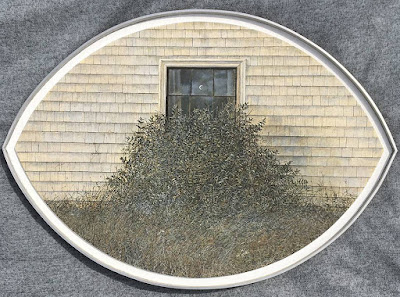When I’m traveling, people often suggest that I look at the work of an artist I don’t know. Here are two I met this summer.
|
The Dinner Hour, 2006, egg tempera, Tom Forrestall, courtesy Mira Godard Gallery, Toronto
|
Tom Forrestallis a magical realist, a term coined in the 1920s by art critic Franz Roh. He meant visual art that explores the inner mystery of our apparently mundane lives. That was in contrast to surrealism, which imposes magic on everyday life.
“[Magic realism] employs various techniques that endow all things with a deeper meaning and reveal mysteries that always threaten the secure tranquility of simple and ingenuous things…. it is a question of representing before our eyes, in an intuitive way, the fact, the interior figure, of the exterior world,” wrote Roh.
In my opinion, Andrew Wyeth is a magical realist, because his narratives transcend mere realism. Forrestall is often called the “Canadian Wyeth” because of his similarity to Wyeth, both in content and because of his meticulous application of egg tempera.
 |
|
Moon, egg tempera, c. 1971, Tom Forrestall, courtesy Atlantic Fine Art
|
Forrestall rejects the notion that paintings should always be rectangular, and makes them in fanciful shapes. The Dinner Hour, at top, is an homage to his late wife, Natalie. Forrestall wrote on the back: “Natalie’s little cross over her kitchen door she hung there many years ago — true to her Acadian roots, it shall hang there while I’m still around.” He and Natalie married in 1958, and she ran his art business and household. “She managed things extremely well and it never rattled her with all these six kids,” Forrestall said.
Forrestall came from Nova Scotia’s Annapolis Valley. He attended Saturday morning art classes at the Nova Scotia College of Art in Halifax. He was awarded a scholarship to the Fine Arts department at Mount Allison University, where he studied with Canadian greats Lawren Harris and Alex Colville. He received one of the first Canada Council grants for independent study, which allowed him to travel throughout Europe. He has been a freelance artist since 1960. He was introduced to me by Nova Scotian artists Michael Fullerand Krista Wells.
 |
|
Water Filled Quarry, oil on linen, Joellyn Duesberry, courtesy Joellyn Duesberry
|
Last weekend at Rye Painters on Location, an auction-goer told me that my work reminded her of the late Joellyn Toler Duesberry. Duesberry once said of her art, “I am not interested in a realist painting, I am not interested in an abstract painting. I am interested in the tension.” That’s a sentiment that rings true to me, although I don’t really see too much similarity in our work.
Duesberry was raised in rural Virginia, and had a deep connection to landscape. “All my life I think I’ve unconsciously tried to re-create the place where bliss or terror first came to me,” she said. “Both emotions seemed so strong that I had to locate them outside of myself, in the land.”
She received a BA with Distinction in art history and painting from Smith College and was awarded a Woodrow Wilson Fellowship. She then earned her master’s degree at New York University Institute of Fine Arts.
 |
|
Rainy Morning in Maine II, 2009, monotype, Joellyn Duesberry, courtesy Metropolitan Museum of Art
|
She moved to Denver in 1985, saying that the clearer air revealed more of the sharp bones of the landscape. But she also spent 40 years painting on the Maine coast. She cited John Marin and Milton Avery as the greatest influences in her art.
In 1986 she was awarded a National Endowment for the Arts grant. This enabled her to work with Richard Diebenkorn. He encouraged her to try monotype printing, and she began actively producing and exhibiting her monotypes along with her plein-air paintings.
